Introduction
Questions shape how we see the world. When students learn to ask insightful questions, they unlock new perspectives, and spark curiosity. Insightful questions are the foundation of meaningful discussions, innovation, and personal growth, and they create learners who think critically and independently.
But for many students, asking insightful questions doesn’t come naturally. Whether it’s fear of being wrong, lack of exposure to open-ended thinking, or a classroom culture that prioritizes answers over inquiry, several barriers stand in the way. Let’s explore why this happens and how educators can turn it around.
Why Many Students Struggle to Ask Questions
- Confidence takes a hit. Many students are hesitant to ask questions because they fear looking unintelligent or unprepared in front of their peers. This self-doubt limits their willingness to explore topics deeply.
- The focus is on the answer, not the process. Traditional education often emphasizes memorization and correct answers, leaving little room for open-ended thinking or inquiry-driven learning.
- They don’t know how to ask. Without guidance or exposure to models of effective questioning, students may not develop the skills to frame insightful, meaningful questions.
Practical Ways to Teach Students to Ask Insightful Questions
Helping students ask insightgful questions starts with intentionality. Teachers can foster a culture where curiosity is celebrated and mistakes are seen as opportunities for growth. By modeling the art of asking insightful questions and providing tools to guide the process, educators can empower students to step out of their comfort zones and engage in deeper learning.
- Model curiosity in action. Teachers can demonstrate their own thought process by asking open-ended questions during lessons, showing students how to dig deeper into concepts. For example: “Why do you think this happened?” or “What are some other possibilities?”
- Make it safe to ask. Create a classroom environment where all questions are welcomed and celebrated, even if they seem simple or off-track. Encouraging inquiry without fear of judgment builds confidence and curiosity over time.
- Challenge students to flip the script. During discussions or reviews, ask students to create their own questions about the material instead of answering yours. Reward the most thought-provoking or creative ones with positive feedback or participation points.
6 Highly Curated Strategies to Teach Students to Ask Better Questions
1. Make questioning part of lesson planning.
What it is: Effective questioning requires intentionality. By embedding questioning into lesson planning, educators create a structured framework that encourages curiosity and critical thinking at every stage of the learning process.
With the integration of tools like AI-powered lesson planners, this process becomes even more accessible. AI can help educators identify opportunities within a lesson to foster inquiry and generate question prompts aligned with their objectives.
How to do it: Generative AI like Edcafe AI’s Lesson Plan Generator can streamline this very process. By simply inputting your topic, learning objectives, and a specific instruction to incorporate strategies that encourage students to ask insightful questions, you can receive a comprehensive lesson plan tailored to your needs.
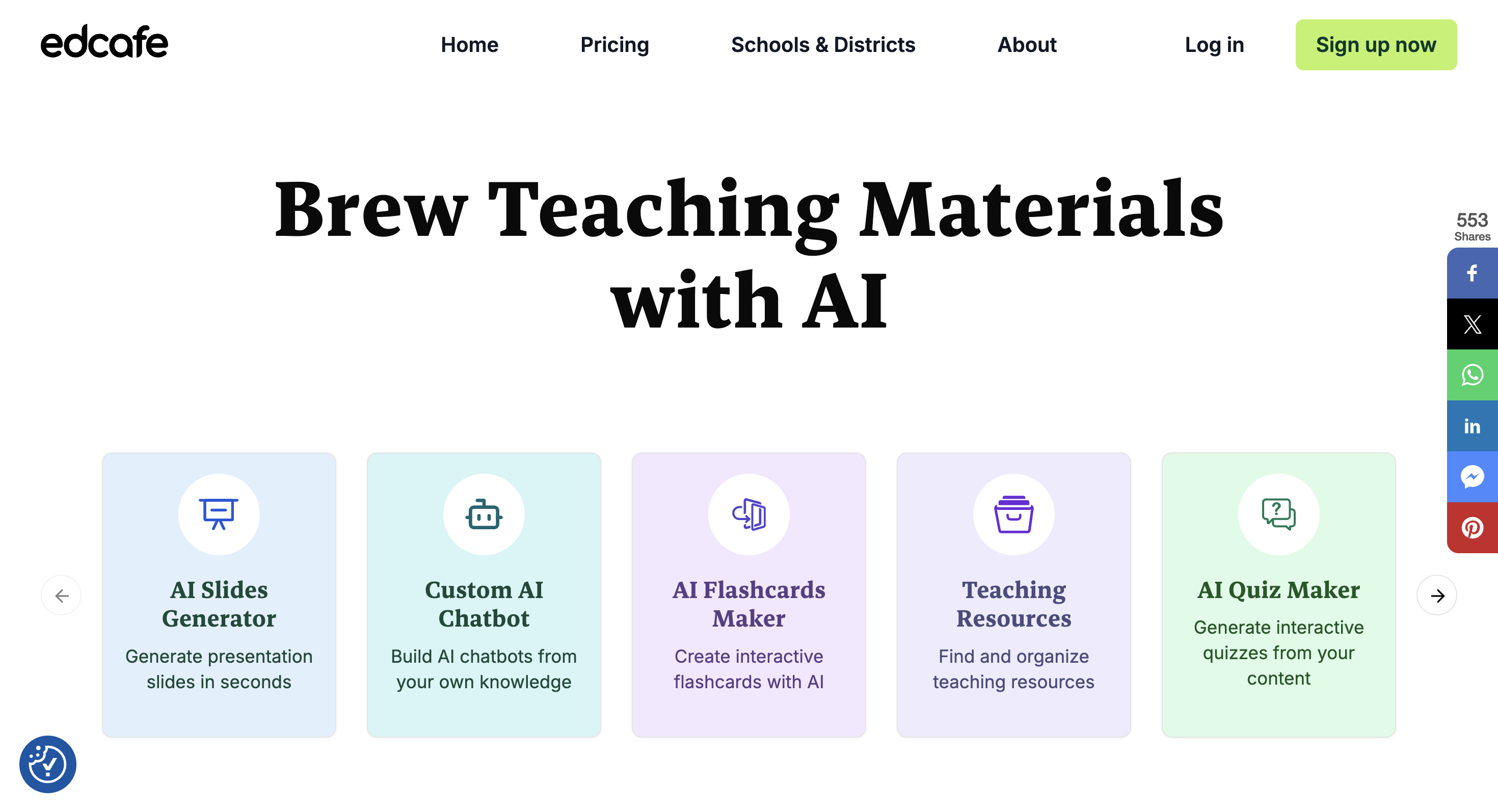
For example, with a topic like Understanding and Creating Simple Narratives, you could specify that the lesson plan should include activities where students actively generate their own questions at different stages. A sample prompt could be:
I need a lesson plan for a middle school English class on ‘Understanding and Creating Simple Narratives.’ The lesson should be interactive and designed to encourage students to ask questions. Please include:
- A guiding question to frame the lesson.
- Opportunities for students to ask their own questions during key activities.
- Activities that prompt curiosity, such as analyzing examples of narratives, brainstorming story ideas, or reflecting on narrative structure.
- Specific instructions for facilitating peer-to-peer questioning and group discussions.
- A reflective exercise where students pose questions about their narratives or their classmates’ stories.
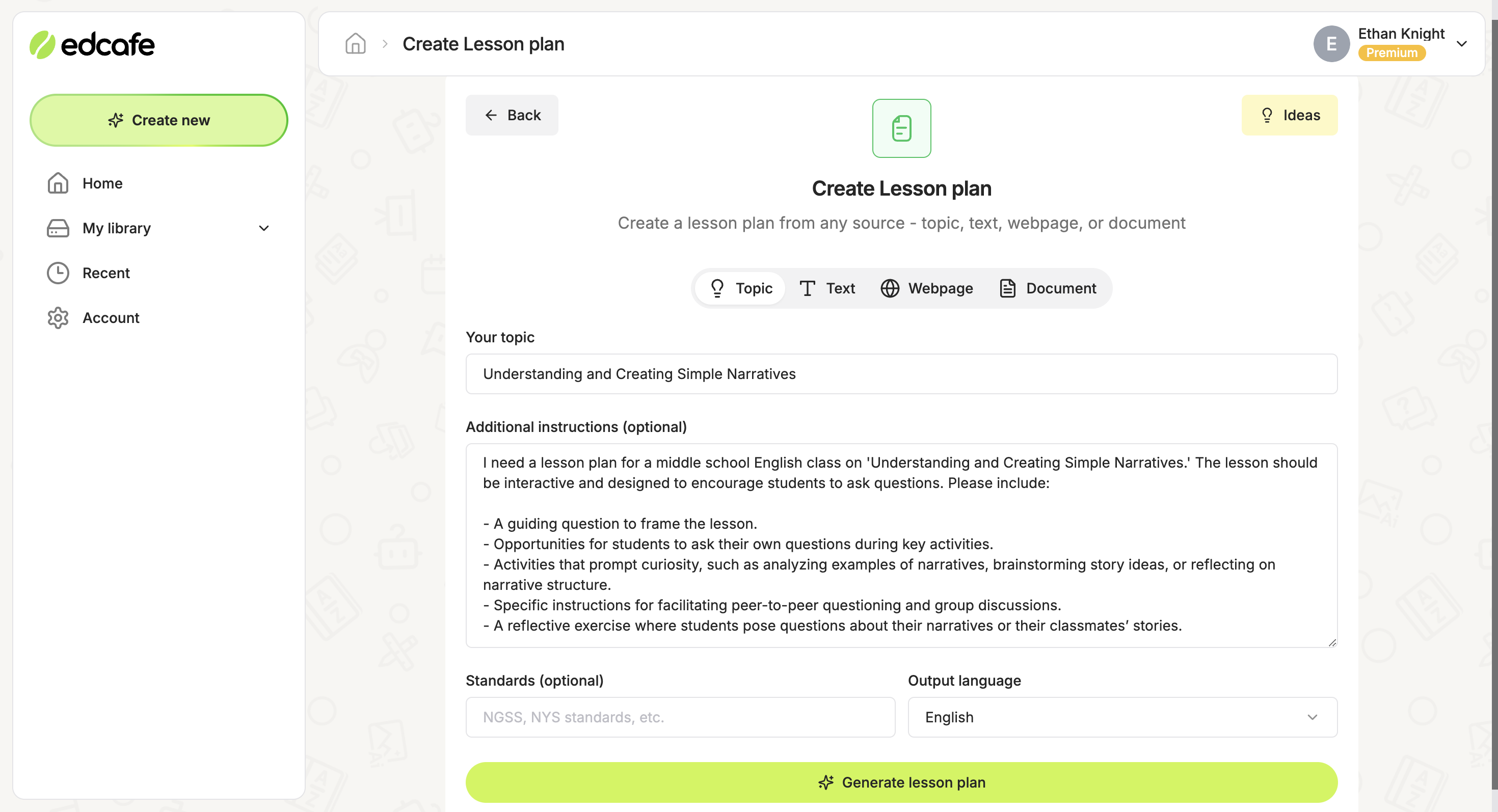
With Edcafe AI’s latest language models, you can be sure that the generated output will be both insightful and tailored to your needs. The models are designed to understand nuanced instructions, ensuring that the lesson plan incorporates creative and practical elements like encouraging student-driven questioning.
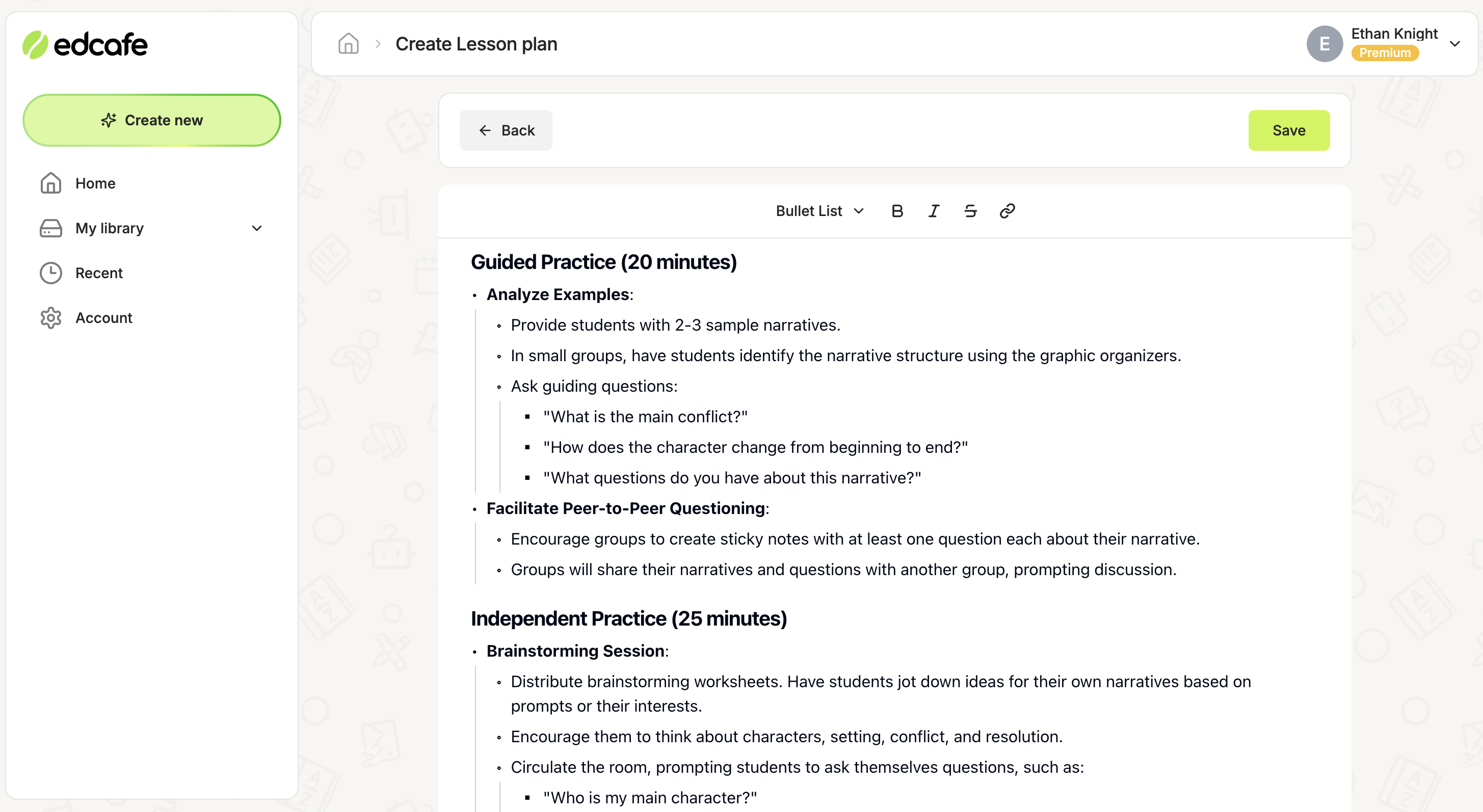
Save your materials in an organized folder system, much like Google Drive, but tailored specifically for your Edcafe AI-generated teaching resources. Need to collaborate? Simply generate a shareable link to effortlessly share your lesson plans with colleagues. This makes duplicating and customizing content a breeze.
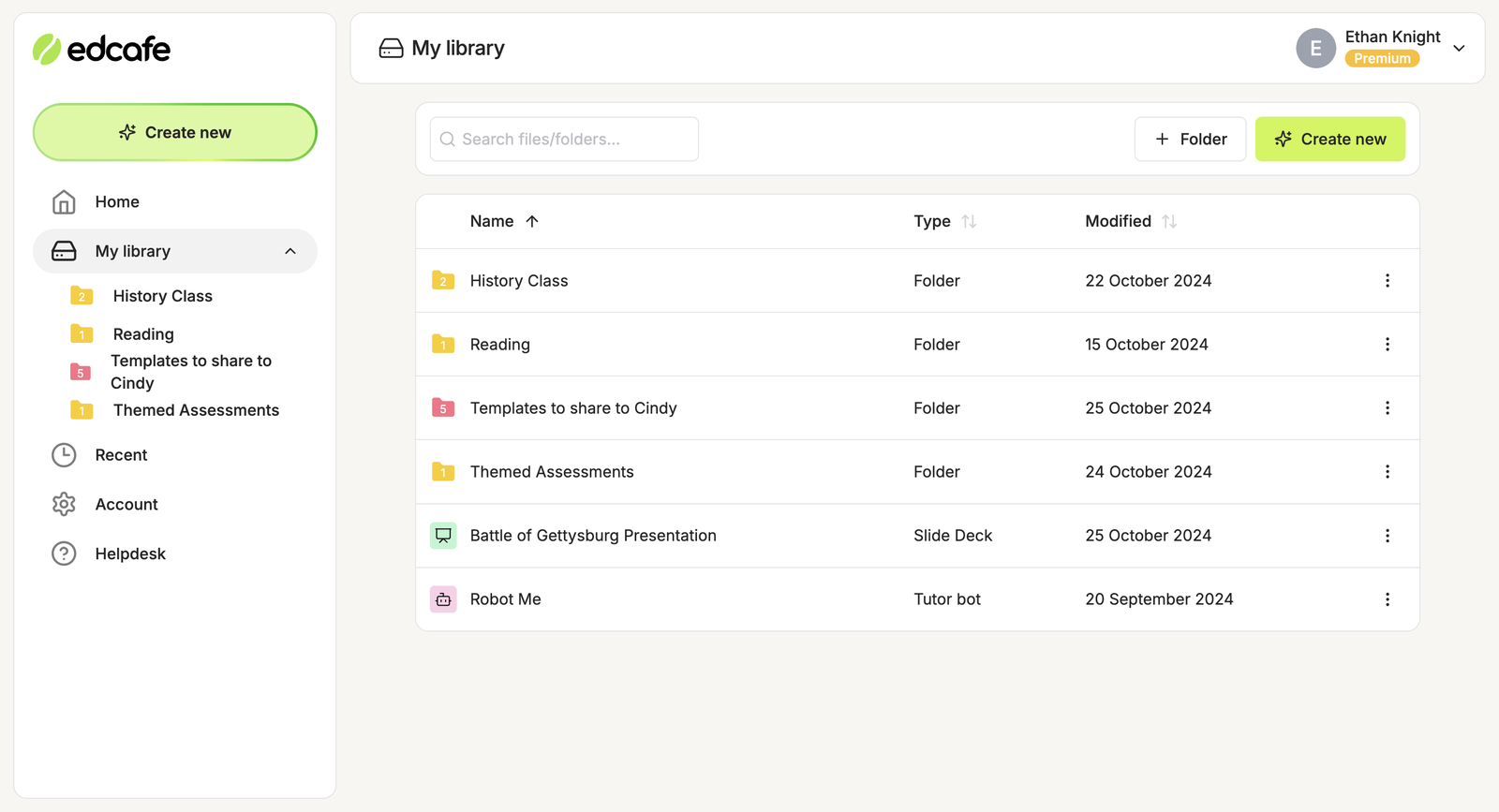
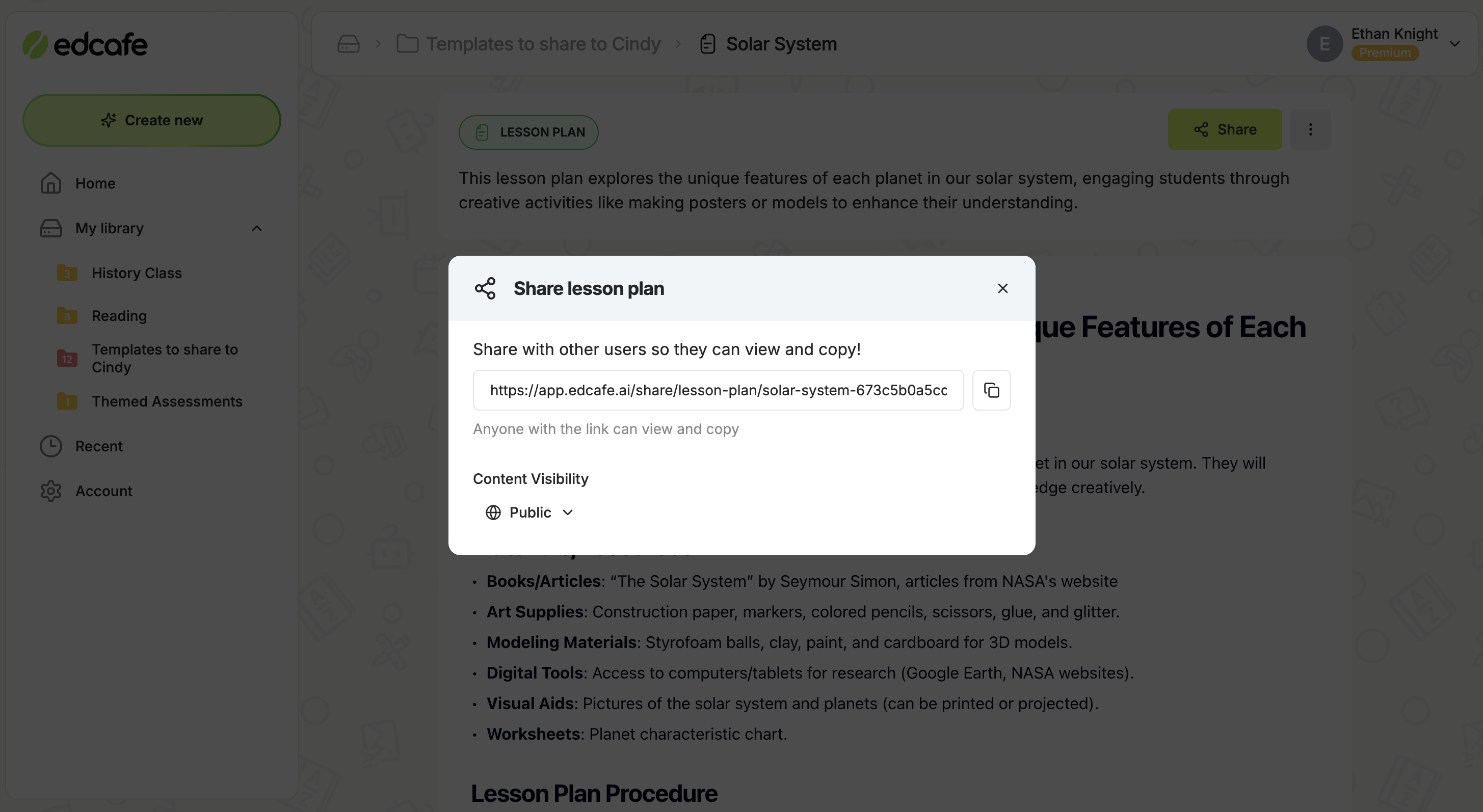
2. Reverse the questioning process.
What it is: Reversing the questioning process means shifting the traditional approach where teachers ask the questions and students respond. Instead, students take the lead by generating the questions themselves, flipping the dynamic to make inquiry their responsibility.
This approach works particularly well with open-ended topics or lessons that require analysis, reflection, or problem-solving. By putting students in the driver’s seat, you help them build confidence in their ability to navigate content and think critically about what they’ve learned.
How to do it: To reverse the questioning process effectively, start by giving students a piece of content to analyze—a story, a science experiment, or a historical event. Then, guide them to take the lead by formulating their own questions instead of answering yours. Here’s how:
- What do you think the author/creator wanted us to understand about this topic? Encourage students to infer intentions and analyze underlying messages.
- If you were explaining this to someone else, what questions would you expect them to ask? This pushes students to anticipate curiosity and frame the content from a teaching perspective.
- What might someone who disagrees with this perspective ask? Promote critical thinking by encouraging alternative viewpoints and counterarguments.
- How could this concept be applied to solve a real-world problem? Connect the lesson to practical applications, fostering creativity and relevance.
- What’s missing from this explanation, and how could we find the answers? Highlight the importance of identifying gaps in understanding and pursuing further exploration.
3. Create a question bank for every topic.
What it is: A question bank is a curated collection of questions related to a specific topic, designed to stimulate curiosity, critical thinking, and deeper engagement with the subject matter. Unlike traditional question sets used for quizzes or exams, this bank serves as a dynamic resource that both teachers and students can draw from for discussions, reflections, and collaborative activities.
By having a question bank for every topic, teachers ensure that inquiry is a consistent part of their lessons. The key is to include a variety of question types—ranging from simple factual inquiries to complex, open-ended prompts—that encourage diverse thinking and engagement.
How to do it: Start by categorizing your question bank into different levels or types to cater to various learning objectives. For instance:
- Starter Questions: What is the main idea of this topic? Why is it important to learn this?
- Exploratory Questions: What are some real-world examples of this concept? How does this connect to what we’ve learned before?
- Critical Thinking Questions: What are the strengths and weaknesses of this argument? How would you solve this issue differently?
- Creative Questions: How could we present this topic in a story, diagram, or video? What alternative scenarios can you imagine?
Incorporate the question bank into your lessons by:
- Displaying a few key questions at the start of class to guide discussions.
- Allowing students to choose questions to answer or debate in groups.
- Using questions from the bank as exit tickets or reflective prompts at the end of the lesson.
4. Provide a question quota for class discussions.
What it is: A question quota is a simple yet powerful strategy where students are required to ask a set number of questions during class discussions. Rather than being passive participants, students actively contribute by generating inquiries, ensuring that everyone engages with the material.
This approach shifts the focus from merely answering questions to fostering curiosity and deeper understanding. By setting a quota, you normalize the act of questioning and create an environment where students feel encouraged to speak up.
How to do it: To implement a question quota effectively, you can use a simple table like the one below to guide expectations and measure participation. This rubric serves as both a reference for students and a tracking tool during discussions:
| Category | Quota | Examples of Questions | Purpose |
|---|---|---|---|
| Clarifying Questions | Each student must ask at least 1 | “What does this term mean?” “Can you explain that point further?” | To ensure everyone understands the material fully. |
| Exploratory Questions | Each student must ask at least 1 | “What other examples can we find?” “How does this connect to real life?” | To deepen engagement and connect ideas. |
| Critical Questions | Each student must ask at least 1 | “What are the pros and cons of this argument?” “Why might this not work?” | To analyze and evaluate the material critically. |
| Creative Questions | Optional, bonus credit for 1 | “What if this event happened differently?” “How can we apply this today?” | To inspire curiosity and explore alternative views. |
To use the table:
- Introduce the quota system at the start of a discussion, sharing the rubric with students so they know the expectations.
- Use the Examples of Questions column to provide students with prompts or ideas, especially for categories they might find challenging.
- Track student contributions in real time, using the table as a visual guide. For instance, write down student names under each category as they contribute insightful questions.
- Reward creativity or particularly insightful questions to encourage a high standard of participation.
If you're using PowerPoint to deliver lessons, award stars to your students to gamify your classroom using ClassPoint.
5. Start with misconceptions to spark curiosity.
What it is: Starting with misconceptions involves presenting students with common misunderstandings or incorrect assumptions about a topic at the beginning of a lesson. This strategy taps into the natural human instinct to correct errors, which sparks curiosity and invites students to engage with the material more deeply.
How to do it: To implement this strategy, follow these steps to effectively spark curiosity through misconceptions:
- Identify common misconceptions related to your topic. These can be drawn from common myths, outdated beliefs, or misunderstandings students often bring to class.
- Present the misconception clearly at the beginning of the lesson, framing it as a belief that many people hold, but might not be true. For example: “Many people think that humans have always lived with dinosaurs. Let’s explore why that’s a misconception.”
- Guide the class to the correct understanding. Through collaboration and evidence, help students arrive at the accurate information. Ask them how they came to this new understanding.
- Link the corrected concept to real-world examples. Make sure to show how the corrected idea applies to real-life situations, current events, or practical use, reinforcing its importance.
6. Incorporate “three-level questioning”.
What it is: Three-level questioning is a strategy that encourages students to engage with content at varying depths. The technique categorizes questions into three levels: basic recall, application, and higher-order thinking. This progression helps students not only retain facts but also understand concepts more thoroughly, apply them to new situations, and think critically about them.
- Level 1 (Recall): These questions focus on basic facts, details, and knowledge students can directly recall from the lesson. They test understanding of key concepts and terminology.
- Level 2 (Application): These questions require students to apply what they’ve learned to different situations, making connections between knowledge and real-world scenarios.
- Level 3 (Higher-Order Thinking): These questions challenge students to analyze, evaluate, or create new ideas based on the information they’ve learned. They promote critical thinking and problem-solving skills.
How to do it: To incorporate “Three-Level Questioning” into your lessons, follow this guide:
| Step | Action | Example Questions | Purpose |
|---|---|---|---|
| Level 1 | Start with basic recall questions. | “What is the capital of France?” “What is the formula for water?” | To check students’ basic understanding and recall of facts. |
| Level 2 | Move to application-based questions. | “How would you use this formula in a lab experiment?” “What might this concept look like in a real-world scenario?” | To challenge students to apply what they’ve learned. |
| Level 3 | End with higher-order thinking questions. | “What are the potential consequences if we didn’t have this law?” “How would you alter this theory based on new research?” | To encourage deep thinking, analysis, and critical evaluation. |
| Encourage Student Questions | Let students create their own three-level questions. | “What questions do you have at each level?” | To foster independent thinking and active participation. |
Why It Matters: Is Teaching Students to Ask Insightful Questions Really Important?
When the focus is shifted to teaching students how to ask insightful questions, we empower them to become active participants in their learning journey. In a world where information is constantly evolving and is easily accessible, it’s not enough to just memorize facts. What truly matters is the ability to ask insightful questions that spark curiosity, and encourage critical thinking.
So, as you teach your students, it’s worth pondering: are you preparing them to passively absorb information, or are you nurturing their ability to think independently and question the status quo? Teaching students to ask insightful questions prepares them for life beyond the classroom, where adaptability, the ability to think critically are essential.
